Iowa's bike trails, tourism ambitions grow along with RAGBRAI
When the first edition of what would become RAGBRAI rolled into Ankeny on Aug. 29, 1973, it had 500 riders and the city had 9,000 residents.
The golden anniversary edition of the Register's Annual Great Bicycle Ride Across Iowa will again visit Ankeny on Wednesday But now those numbers ― riders and population ― are exponentially larger.
RAGBRAI, which has grown to be the world's biggest annual bicycle tour, has an unprecedented 28,000 registered riders this year and is expected to draw an equally unprecedented number of tag-alongs for the ride from Ames to Des Moines. RAGBRAI organizers expect it to set the one-day ride record.
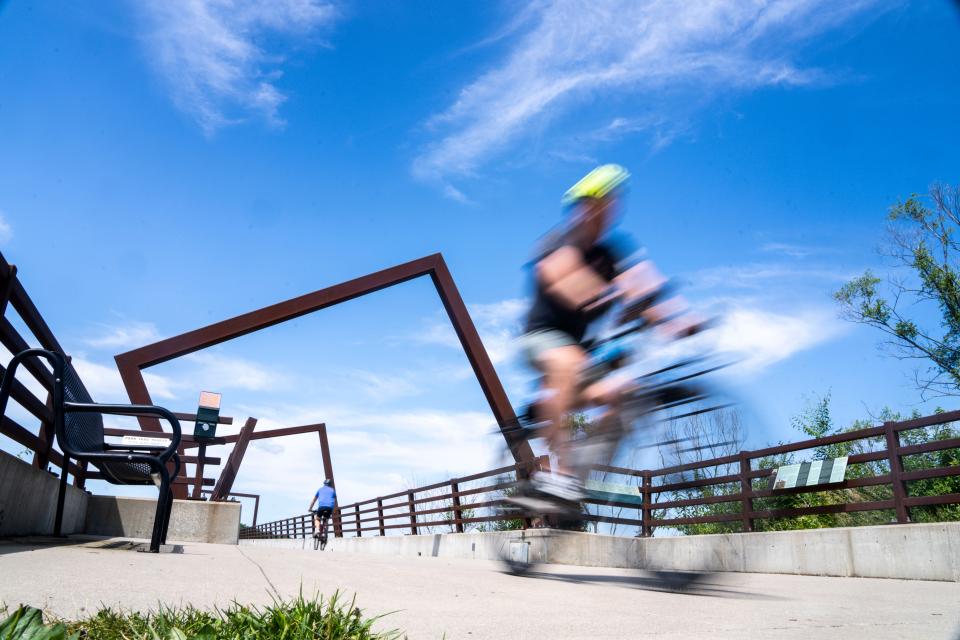
And Ankeny, Wednesday's midpoint meeting town on the ride, is now the sixth-largest city in Iowa and the second in the metro area after Des Moines, with a population of about 72,000.
The growth of cycling as a form of recreation and as an industry is at the center of RAGBRAI's success, and also has played a role in making Ankeny a booming hometown for people seeking an active lifestyle. One of the state's most popular trails, the High Trestle, has its southern trailhead in the city.
More: As RAGBRAI grows from lark to legendary at age 50, it still offers glimpses of 'authentic Iowa'
With its signature bridge over the Des Moines River west of Madrid, completed in 2011, the High Trestle has become a bonafide tourist attraction, drawing 45,000 visitors annually from outside Iowa, according to a 2019 Ankeny study on the economic impact of cycling.
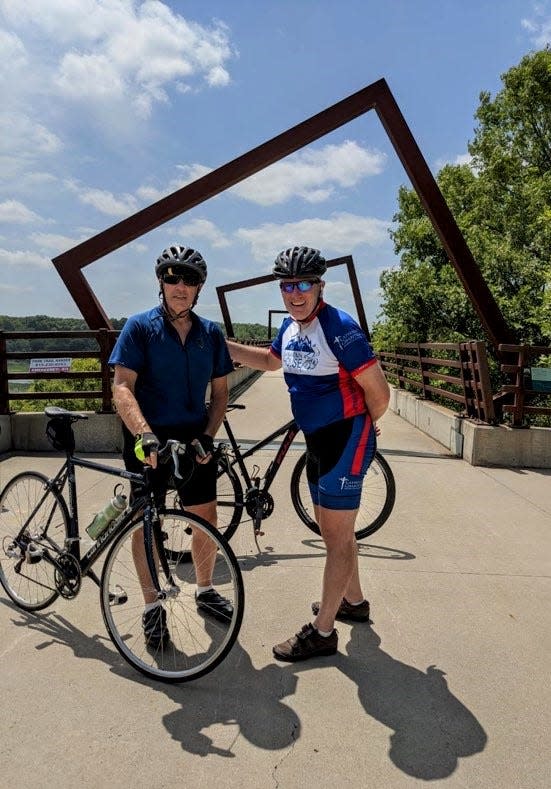
Among them is Gary Landers. The 66-year-old was a longtime photographer for the Cincinnati Enquirer and other press agencies in Ohio. Now retired in Cincinnati, Landers decided that he would ride on a bike trail in every state.
In July 2020, he met his brother Scott, a Denver resident, in Iowa to ride the High Trestle Trail.
“That view from that bridge was worth the payoff of the ride,” he said. “It was absolutely fantastic.”
And while he doesn't count himself as a big spender, he said he stays in local hotels, eats at local restaurants and shops at local stores on his bike expeditions, so far encompassing 32 states.
“I like going to those little towns and poking around," he said. "I like visiting some of those small towns, learning the history as well.”
Ankeny prepares for trail connection that's a 'game changer'
Ankeny Economic Development Director Derek Lord said he recently encountered a far-flung couple, “one was from New York, one was from California," who met in high school, dated, reconnected at a reunion "and decided to meet in the middle, and they end up in Ankeny visiting the High Trestle Trail.”
Construction is expected to be completed next year on a 9-mile connection between the High Trestle Trail and the Raccoon River Valley Trail, which starts in Waukee. The result will be a 120-mile loop that also connects with Des Moines, Windsor Heights, West Des Moines, Clive, Urbandale, Waukee, Adel, Perry, Woodward, Slater and other metro Des Moines communities, with links to more distant destinations including Jefferson and Marshalltown.
Lord called the connection a “game changer” that he expects to draw even more bicycle tourists, boosting local restaurants and hotels.
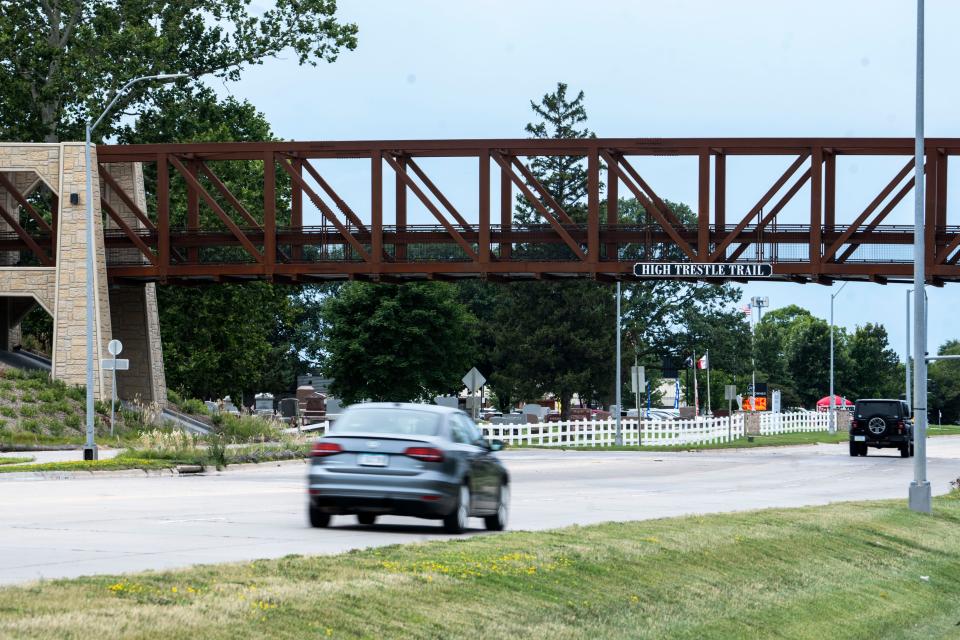
Ankeny is getting ready. Where the High Trestle intersects trails in the city connecting to downtown Des Moines, Altoona and Bondurant, the city in 2022 built an elaborate, $3 million bridge to carry riders over busy Oralabor Road, with plans for further aesthetic enhancements. Two new hotels have risen adjacent to the bridge.
“If you’re going to draw people from out of town, they need to be able to walk out of their hotel room to the trail,” Lord said.
“The High Trestle Trail is a big part of our community’s identity,” he added. “Communities are always searching for things and some have to search harder for things that add to, contribute and strengthen their identity. Trails can be part of that.”
More: How to roll with it: What you need to know about RAGBRAI L's July visit to Des Moines
Since 2016 Ankeny has spent nearly $13 million on bike trail projects like the bridge, with $6 million coming from grants, private contributions and funds raised by the city's hotel/motel tax, said Amy Baker, a spokesperson for the city.
Bike-oriented projects in the city also include the $2 million Ankeny Market Pavilion in the Uptown district, a multipurpose facility that serves both as a farmers' market and a heavily used hub for riders on the High Trestle Trail.
Riders often end their rides there with a visit to the adjacent Firetrucker Brewery, the upscale Trailside Tap and a growing number of other drinking and dining options. A new building next to the trail will soon house the Uptown Dairy ice cream store, a second location of popular Des Moines breakfast spot Mullets and offices, including those of Imprint Architects, one of the firms behind the project.
"When the land became available, with it situated on the bike path, I loved it from the start," Karl Chambers, the president of Imprint, told the Des Moines Register in June.
Ankeny also has built a lacework of trails and bike lanes throughout the city, connecting to the major trails.
Other Des Moines metro communities embrace cycling
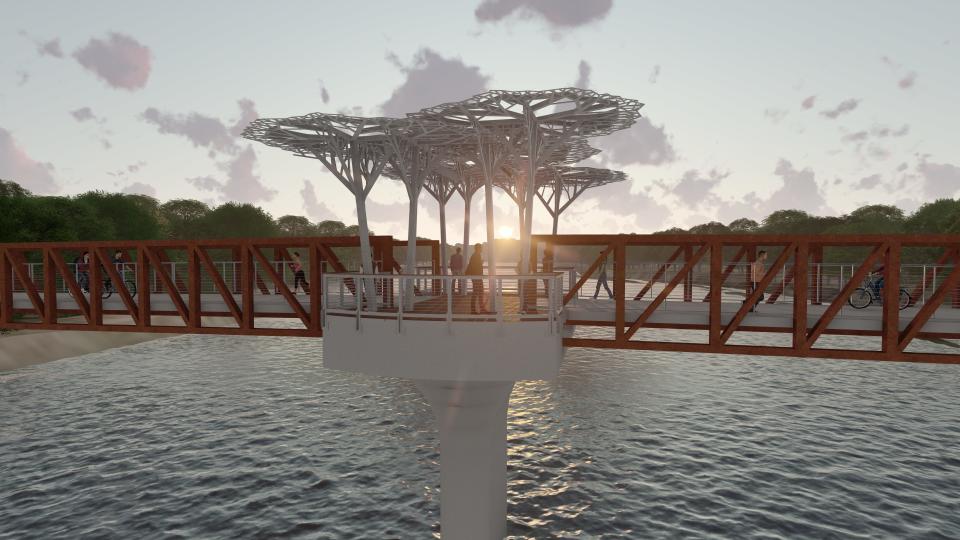
Ankeny is hardly alone in its enthusiasm for two-wheeled recreation and its economic possibilities. West Des Moines, with a long-developed trail network, recently broke ground for its own signature span, the 620-foot Athene Pedestrian Bridge that will connect Raccoon River Park and its bike trails with Walnut Woods State Park across the Raccoon River at a cost of $9.3 million.
The Waukee Betterment Foundation in 2018 spent $1.1 million for a public art installation marking the trailhead of the Raccoon River Valley Trail's existing 72-mile loop through Dallas, Green and Guthrie counties. And in 2020, Kinship Brewing Co. opened its sprawling tap room, patio, dog park and more recently, a restaurant, just off the trail, with a trail spur leading to rows of bike racks next to its entrance.
Ankeny neighbor Polk City, another Wednesday RAGBRAI stop on the route to Des Moines, also has ambitions as a biking destination, and is planning a link to the High Trestle Trail.
“Cycling is very much in our planning for the future,” Mayor Steve Karsjen said when the RAGBRAI route inspection ride visited his town square in June. With its proximity to Saylorville and Big Creek lakes, “we want to promote Polk City as central Iowa’s recreation destination, and cycling is a big part of that,” Karsjen said.
Des Moines, meanwhile, is working to add 12 miles to its 68-mile paved trail network, which had just three miles of trail ― still under construction ― when the nascent RAGBRAI passed through in 1973. One of the planned additions, the 3.7-mile Central Place Levee Trail, will connect to downtown via an existing byway and wind through neighborhoods like River Bend, King Irving, Chautauqua Park, Prospect Park and Cheatom Park, bringing a new recreational opportunity to areas with some of the city's highest proportion of low-income families and nonwhite households.
More: See where Des Moines plans to add new multi-use bicycle and pedestrian trails
Des Moines' trail network is one of its most popular amenities, according to the city's website, with more than 1 million trips a year. And the wider Des Moines metro now has more than 800 miles of multiuse trails, which over the last 12 months drew 839,000 riders, according to data obtained from trail counters around the regional trail network, said Dylan Mullenix, interim executive director of the Des Moines Metropolitan Area Planning Organization.
In Lake View, cycling fuels thriving business district
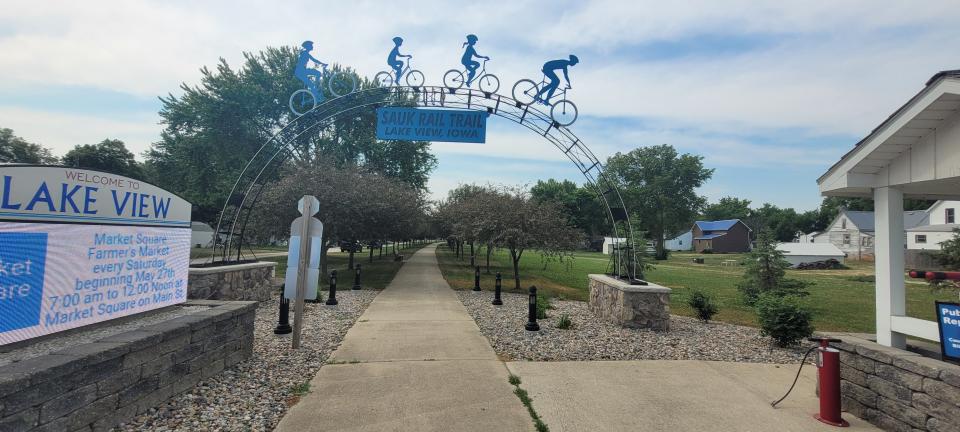
Iowa's interest in biking reaches far beyond the Des Moines region. In April 2022 Gov. Kim Reynolds announced the state would make $100 million in Destination Iowa funds available through the American Rescue Plan to create tourism attractions and improve recreational amenities. A fifth of the projects were bike trails in areas including the Sioux City, Cedar Rapids and Waterloo metros as well as the High Trestle-Raccoon River Valley connector, receiving a combined total of $22.9 million.
Lake View, the Day 2 meeting town for RAGBRAI's 50th anniversary ride, is keenly aware of cycling's economic potential. It's the northern trailhead of the 33-mile Sauk Rail Trail, which Mayor John Westergaard said helps support five bars and restaurants, an outdoor shop and three boutiques selling trail-branded merchandise in the town of 1,117.
Signs for street names on north-south throughfares in the city have a bike image emblazoned on them. East-west signs carry the image of a boat, a nod to the town's location on the shore of Black Rock Lake.
The boaters are valued visitors, but it's the bikers whom Westergaard credits for vitality of the town's business district.
“The one thing bikers bring is money. They don’t bring coolers," Westergaard said, adding that when there are group rides on the trail, "There might be 100-something bikes out in front of the bars waiting for the ride to start."
Altogether, Iowa has 3,060 miles of multiuse trails, said Andrea Henry, a spokesperson for the Iowa Department of Transportation.
Could trails one day reach across Iowa?
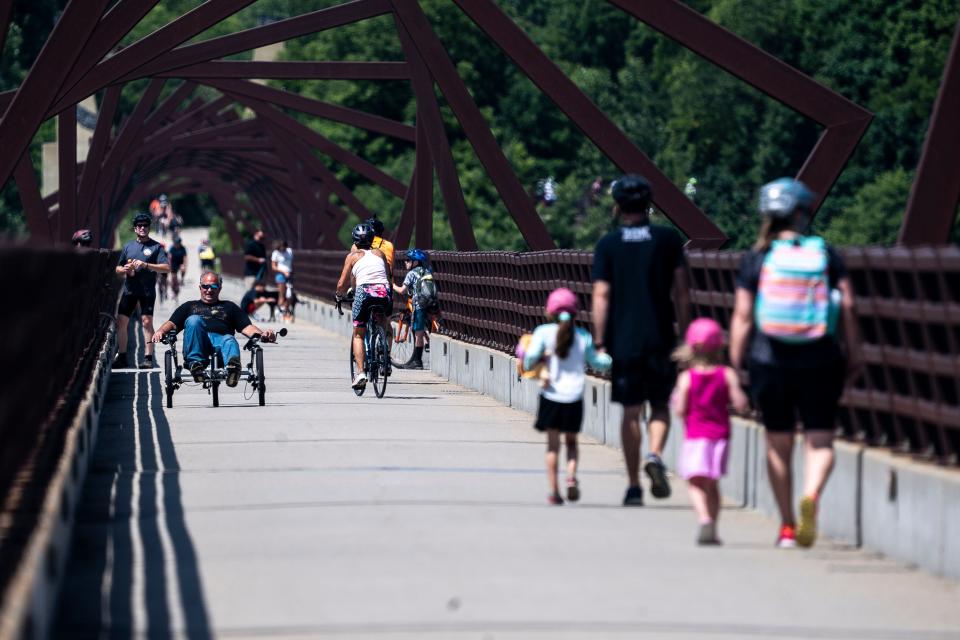
There are several factors that generated the opportunity for bike-oriented recreation in Iowa. A major one was the shrinkage of the state's rail lines since the 1960s, leaving thousands of disused railbeds that were ready-made for conversion to trails. Also, much of Iowa has a level-to-rolling topography that's cyclist-friendly.
And for a half century, Iowans' appetite for biking has been fired by its world-famous, annual cross-state bike ride, dreamed up by Des Moines Register journalists John Karras and Donald Kaul. Stories of people young and old from around the state, nation and world coming for a weeklong adventure in the improbable setting of the Iowa countryside awakened the state's residents to the possibilities of the sport, once thought of mainly as a pastime for children.
Cycling now contributes more than $360 million in direct and indirect economic impact to Iowa, according to the Iowa Bicycle Coalition. Midwest Living cited RAGBRAI in 2022 when it dubbed Des Moines, with its trail network, as one of the most bike-friendly destinations in the Midwest.
"Nobody has put more people on bicycles in the world than Donald Kaul and John Karras," said Iowa Bicycle Coalition Executive Director Mark Wyatt. "If you think about it, how many people they’ve inspired to come to Iowa and ride their bike across the state year after year after year for 50 years, that’s amazing, the legacy that those two people started."
And it's given Iowa something to claim as its own.
‘We don’t have mountains here," said Carl Voss, a Des Moines City Council member who in 1973 was a Register photographer helping cover the initial ride. "We don’t have oceans. But we have bikes.”
Lake View is slowly acquiring land for a 7-mile trail around Black Hawk Lake. Westergaard dreams of the day when trails will connect the town with northwest Iowa tourist mecca Lake Okoboji, Des Moines and potentially the High Trestle Trail ― part of a network that could eventually span the state, making a great bicycle ride across Iowa possible whenever bike tourists are ready for it, not just during the last week of July.
“That’s where the money’s at,” Westergaard said. “I believe someday it will get here."
Philip Joens is riding his 18th RAGBRAI. He has completed the river-to-river trek six times. He covers retail, real estate and RAGBRAI for the Des Moines Register and can be reached at 515-284-8184 at pjoens@registermedia.com or on Twitter @Philip_Joens.
This article originally appeared on Des Moines Register: As cycling grows alongside RAGBRAI, Iowa economies thrive
